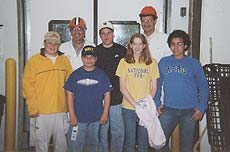|
Features,
Honors
& Awards, Ag
Announcements
Calendar,
Ag News Elsewhere
(fresh daily from the Web)
|
|
Features
|
|
Weekly outlook
Prices
and prospects
[MAY
20, 2003]
URBANA -- Recent price
strength provides an opportunity for producers to advance sales of
both old and new crop corn and soybeans, said a University of
Illinois Extension marketing specialist.
|
|
"The strong basis in some areas and
inverted futures market suggests that all old crop inventory should
be sold," said Darrel Good. "Long positions to speculate on summer
weather markets may be less costly in the futures market than in the
cash market under the current price structure.
"New crop prices for both corn and
soybeans are well above the loan rate in many areas and above the
USDA's projected average for the 2003-04 marketing year if
trend-line yields are reached in 2003."
Good's comments came as he reviewed
recent market actions. Corn and soybean prices were generally higher
again last week, although some weakness was noted on Friday (May
16). Both old and new crop soybean futures established new contract
highs, and the central Illinois average cash price of soybeans moved
to the highest level in nearly five years.
Old crop corn futures moved to the
highest level since early November 2002, while spot cash prices and
new crop futures moved to the highest level since early September
2002.

"Much of the buying interest in corn
and soybeans since the first of May was generated by wet weather in
many areas and the resultant slowdown in planting progress," said
Good. "Additionally, soybean exports continued at a pace above that
projected by the USDA. Given that much of the friendly news for corn
prices was associated with the new crop, it is somewhat surprising
that July 2003 futures were stronger than December 2003 futures."
July futures moved from a 2-cent
discount to December futures at the first of the month to a 45-cent
premium on May 16. In contract, July 2003 soybean futures moved from
a 78.5-cent premium to November futures on May 1 to a 70.25-cent
premium on May 16.
"Given the relative abundance of old
crop corn supplies and the tightness of old crop soybean supplies,
the spreads might have been expected to move in opposite
directions," said Good. "The market may be expecting a sharp decline
in the rate of U.S. soybean exports, as importers increasingly turn
to South American supplies. In fact, the USDA's weekly export
inspection report released on May 19 indicated that exports for the
week ended May 15 totaled only 3.7 million bushels."
Good noted that is about one million
bushels below the weekly rate required to reach the USDA projection
for the year. Reports of some imports of South American soybean meal
into the United States may also be a signal that, while tight,
supplies may be adequate until the new harvest. The level of June 1
inventories will not be revealed until June 30.

[to
top of second column in this article]
|

The soybean price pattern continues to
be more interesting than the corn price pattern. Since 1973-74 (29
years), the average cash price of soybeans in central Illinois has
established a marketing-year high in the spring or summer months 19
times. The high occurred in April once, May four times, June four
times, July eight times and August twice.
"For a historical perspective, then, we
are in the time frame when highs in cash prices should be expected,
with some chance the high may have been established last week," said
Good. "With the entire growing season to unfold, however, prices
could continue to be volatile."
An examination of price patterns for
November 2003 futures provides less confidence that a high has been
established. The November contract has reached a high in May only
once (1990) over the past 32 years. The high to date for the
November 2003 contract of $5.76 is the lowest high for a November
contract since 1972.
The recent strength in corn prices has
left prices well within the range established since September 2002.
The only unusual feature of prices to date continues to be the very
narrow trading range for new crop contracts. December 2003 futures
have a trading range of only 38.5 cents. Since 1971, the December
contract has had a low trading range of 41 cents (1972) and a high
of $2.05 (1974). Since 1989, the trading range has varied from 55
cents to $1.50.

"Historical price patterns are of some
interest and may provide some general guidelines for the current
year, but market fundamentals will dictate how prices unfold over
the next few months," said Good. "The market for corn and soybeans
will likely continue to focus on U.S. crop weather, planting
progress and early crop conditions.
"Another
look at planted acreage of corn and soybeans will not be available
until the release of the USDA's acreage report on June 30. One
popular private source has forecast an increase in both corn and
soybean acreage compared to March intentions."
[University
of Illinois news release]
|
|
 |
|
|
Farm living expenses rise
[MAY
14, 2003]
URBANA -- Total
noncapital living expenses for Illinois farm families rose an
average 2.9 percent between 2001 and 2002 and are up 4.5 percent
since 2000, according to a University of Illinois Extension study.
|
|
"The total noncapital living expenses
of 1,216 farm families enrolled in the Illinois Farm Business Farm
Management Association averaged $44,475 -- or $3,706 a month for
each family," said Dale Lattz, U of I Extension farm management
specialist. "The sample farms, which were mainly grain farms, were
located primarily in central and northern Illinois."
In addition to the living expenses, the
average farm family spent $4,380 in 2002 to buy capital items such
as the personal share of the family automobile, furniture and
household equipment, said Lattz.
"The grand total for living expenses
averaged $48,855 for 2002, compared with $48,097 for 2001," he said.
"This represents a $758 increase per family."

[to top of second column in this
article]
|

Income and Social Security tax payments
decreased in 2002 compared with the year before. The amount of
income taxes paid in 2002 averaged $9,867, compared with $11,475 in
2001.
"The amount of taxes paid was at its
lowest level since 1990," said Lattz.
Medical expenses were higher in 2002
compared with 2001. In 2002, medical expenses averaged $6,335.
"This is the first year medical
expenses averaged over $6,000," Lattz said. "Medical expenses
include out-of-pocket costs for health insurance, along with doctor
and hospital expenses."
The complete
report is available online at
http://www.farmdoc.uiuc.edu/manage/
newsletters/fefo03_09/fefo03_09.html.
[University of Illinois news release] |
|
|
Corn,
soybean costs drop
across Illinois in 2002
[MAY
13, 2003]
URBANA -- Total costs per
acre to produce corn in Illinois dropped an average of 5 percent
from 2001 to 2002, and total costs per acre for soybeans also
dropped over the same period, according to a University of Illinois
Extension study.
|
|
"Total costs to produce corn for all
combined areas of the state were $401 per acre in 2002," said Dale
Lattz, U of I Extension farm management specialist, who wrote the
report, "Costs to Produce Corn and Soybeans in Illinois-2002," based
on data from the Illinois Farm Business Farm Management Association
record-keeping project. "This figure represents a 5 percent decrease
in one year.
"Total costs per acre to produce
soybeans also decreased, from $338 per acre in 2001 to $326 per acre
in 2002."
Driving the decreases, Lattz said, were
reductions in fertilizer, non-land interest charge and land costs.
"For corn, total costs per acre were
the lowest since 1995, when they were $395 per acre," said Lattz.
"Total costs per bushel were the highest since 1997. Total costs per
acre for soybeans were the lowest since 1995."
The entire report is available online
at:
http://www.farmdoc.uiuc.edu/manage/
newsletters/fefo03_08/fefo03_08.html.
Production costs varied among the
state's regions and soil types. Total per acre costs for corn
averaged $411 in the northern section and $416 in the central
section for areas with high soil ratings. Costs were $391 per acre
in the central section for farmland with low soil ratings and $350
per acre in the southern section. Soybean costs in the high soil
areas of northern and central Illinois were $337 and $341
respectively. Costs in the low soil areas of central Illinois were
$312 per acre and $275 per acre in southern Illinois.
[to top of second column in
this article]
|

"Costs were lower in the southern part
of Illinois primarily because of lower land costs," said Lattz. "The
total of all economic costs per bushel in the different sections of
the state ranged from $2.59 to $3.61 for corn and from $6.24 to
$8.09 for soybeans.
"Variations in this cost were related
to weather, yields and land quality. Southern Illinois had the
highest costs per bushel to produce corn and soybeans because of
below average yields caused by last summer's dry weather."
Farms
located in the 22 counties north and northwest of the Illinois River
constitute the northern region. Farms from 36 counties below a line
from about Mattoon to Alton are in the sample for southern Illinois.
The remaining 44 counties make up central Illinois.
[University
of Illinois news release]
|
|
|
StarLink settlement deadline
[MAY
13, 2003]
URBANA -- Most Illinois
farmers face a May 31 deadline to submit a claim in order to receive
their share of a $110,000,000 national settlement recently approved
by the U.S. District Court in Chicago, said Don Uchtmann, University
of Illinois Extension agricultural law specialist.
|
|
"Although quite a few Illinois
producers have submitted their claim, many others are eligible to
participate in the StarLink settlement and receive about $1 or $2
per acre, maybe more, for each acre of non-StarLink corn harvested
as grain in 2000," said Uchtmann.
The exact payment per acre depends on
how many U.S. farmers submit claims.
"If a particular farm operator doesn't
submit a timely claim, that farm operator's share of the settlement
will just be distributed among others who do submit timely claims,"
he said.
"The settlement is a compromise between
farmers who filed the class action lawsuits and the companies that
developed and sold StarLink seed. The class action settlement is
intended to compensate all farmers who grew non-StarLink corn in
year 2000 for damage they allegedly incurred because of the StarLink
incident."
StarLink was a genetically engineered
corn variety approved for feed use in the U.S. but not for food use
or export. After StarLink was discovered in taco shells, aggressive
steps were taken to channel all grain containing traces of StarLink
into approved uses. But the presence of StarLink throughout much of
the 2000 corn supply allegedly scared away buyers and depressed the
U.S. price for the entire crop.
Under the court-approved settlement,
there are several types of potential claims, said Uchtmann, but the
most common type will be the "Corn Loss Proof of Claim" for non-StarLink
corn acres harvested for grain in 2000.

[to top of second column in this
article]
|

"Since very few farmers 'opted out' of
the proposed settlement by the March 21 deadline, over 99 percent of
the year 2000 harvested corn acres are potentially eligible for
payment. About $70 million will be distributed, pro rata, over the
corn acres documented by claimants, but the farm operator must mail
the Corn Loss Proof of Claim by the May 31 deadline," he said.
Farmers who lost the original form
mailed to farmers before March 21 can get a new form and filing
instructions from the Internet. The form is not hard to fill out,
especially if the farmer has copies of the Farm Service Agency forms
(form FSA-578) showing year 2000 corn acres for each farm. FSA
offices can provide a copy of this form if needed. The form asks for
acres of corn but does not request yield information.
"It's the farm operator who submits the
form," said Uchtmann, "and then the farm operator has a
responsibility to account to landlords who shared in the crop."
An article
titled
"How to file claims by May 31 for compensation from the non-StarLink
farmer's class action settlement" is available on the farmdoc
website. It provides valuable, practical information and tools and a
link to the official
"Non-StarLink Farmer Litigation" website, where the claim form
can be obtained.
[University of Illinois news release] |
|
 |
|
|
Corn progress
[MAY
12, 2003]
With over 90 percent of the
corn planted, at least the first time, it is important to scout
fields at this time for stand evaluation and pest problems.
Beginning with stand evaluation, the rule of thumb is simply that a
decent corn stand at this time of year is probably going to yield as
well, or better, than a replanted one. With another shower this
week, we would be looking at 91 percent maximum yield from a great
stand (30,000 plants) planted May 19, and we can go down to a stand
of 20,000 plants planted between April 20 and May 4 to achieve at
least a 91 percent yield.

|
|
There are no guarantees the second time
around either. That 30,000 plant stand is hard to achieve. Much of
the guesswork comes in from the reason behind stand loss. If
herbicide problems, some insect problems (such as maggot or beetle)
and disease problems are at the core of the stand problem, then the
stand may not dwindle further. If seedling diseases or other insects
(such as grubs, wireworms and cutworms) are the culprits, then
stands may be further reduced.
Scouting programs may give you the
answers needed for your decision. In the case of insects that may
further reduce your stands, many of these do not have rescue
treatments available for them. That means you either live with what
you have, or you replant and use a recommended insecticide at
replanting. Black cutworm damage should show up for the first time
in Logan County this week, based on moth captures in traps and
degree accumulation data. Wireworm and grub problems are also just
beginning to be noticed.

[to top of second column in
this article]
|

Cool, damp conditions also lead to some
of the seedling disease problems, such as penicillium. Many of these
problems can't be evaluated until the permanent root system takes
over (another three weeks or so). The end result is that stands must
be evaluated individually, and you should use the smallest area you
are willing and able to manage differently. At any rate, don't plant
alongside an existing row. That system generally takes yield from
both the old and new planting.
On the
soybean side, stand reductions of 30 percent to 40 percent are
generally not going to yield less than perfect stands that are
replanted. The big thing is the number of gaps and the length of
gaps in stands. The other consideration is the amount of shading
provided by the soybean stand and the effectiveness of the shading
in a herbicide program.
[John
Fulton]
|
|
 |
|
|
Honors
& Awards
|
|
Logan County 4-H meats judging
team wins contest
|
|
[MAY
16, 2003]
The junior meats judging team from Logan County 4-H
placed first in a multi-county contest at Morton. Members of the
junior team were David Fulton, Daniel Fulton, Allicent Pech and
Colleen Pech.
Individual junior placings were Daniel Fulton, third, and Colleen
Pech, fourth. Andrew Fulton placed fourth in the senior division.
The local team was
coached by Don Miller.
[News release] |

Pictured in the front row are members of the Logan County 4-H junior
meats judging team: David Fulton, Daniel Fulton, Allicent Pech and
Colleen Pech. In the back row are Tom Carr, a contest official; Andrew
Fulton, fourth-place individual in the senior division; and Dave
Seibert, a contest official. |
|
 |
|
|
Ag
Announcements
|
|
|
|